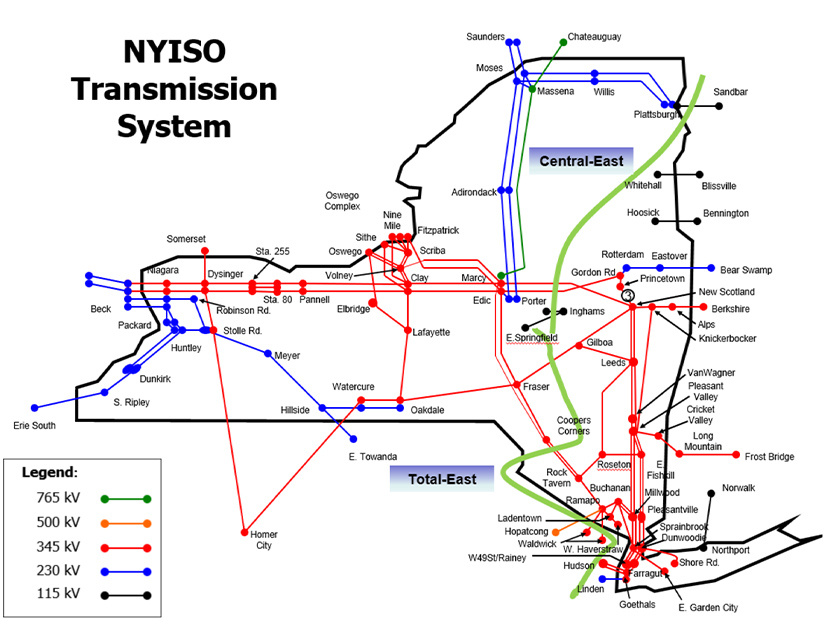NYISO announced Nov. 21 that it has published the final, approved version of the 2024 Reliability Needs Assessment, which identifies a reliability need in New York City beginning in 2033.
The declaration of a reliability need triggers a process in which NYISO solicits solutions, including transmission-based from the local transmission owners, and generation and demand response from market participants.
The NYISO Board of Directors had approved the final draft several days earlier. (See NYISO Board Approves RNA, 2025 Budget.) The RNA’s assumptions changed throughout the stakeholder process. It initially identified a statewide need, but staff revised their concerns downward after they identified “flexible” loads in the cryptocurrency sector. (See NYISO: Large Load Flexibility Eliminates 2034 Shortfall Concern.)
Zach Smith, senior vice president of system and resource planning, elaborated on this shift with Kevin Lanahan, vice president of external affairs and corporate communications, on the ISO’s “Power Trends” podcast.
“We learned partway through this process more details, more operational characteristics of some of these facilities such that we were able to make what we believe is a reasonable assumption that some of these facilities will reduce their demand during these peak demand periods,” Smith said.
“The statewide reliability need was avoided, but it’s looming, fair to say?” Lanahan prompted. “It still kind of looms in the future.”
“It sure does. … On a statewide level, we determined that we do not officially have a reliability need on a statewide basis over the next 10 years. … That’s the good news,” Smith said. “However, in 2034, our calculations show that on a statewide basis … we have a surplus of only 50 MW. That’s very small on a system that’s over 30,000 MW of peak demand.”
With such a small surplus, any small changes in the assumptions about what generation is coming online, and the way that industries draw power, could lead to an official declaration in the short term, Smith said.
Load Forecasting Task Force Updates
The Load Forecasting Task Force presented preliminary updates to its 2024 weather-normalized peak load for the 2025 ICAP forecast at its meeting Nov. 22. These included both the preliminary weather-normalized peak loads for this year and updated growth factors for each transmission zone based on economic data from Moody’s Analytics.
This year’s weather-normalized peak load was 31,292.7 MW, which will be factored into next year’s ICAP forecast. It occurred July 8 during the 5 to 6 p.m. hour.
Max Schuler, a demand forecasting analyst for NYISO, went over the economic indicators for the transmission zones, showing that across the board, real income, GDP, number of households and employment were trending upward, but population was trending downward in each, except in the Orange & Rockland Utilities zone.
“If households are increasing but population is going down, what does that mean?” asked Howard Fromer, director of regulatory affairs for Bayonne Energy Center.
“These are all very slight changes for household and population,” Schuler said. “But it’s a continuing trend of fewer people per household … as younger people move out without their parents to start their own house.”
New York State Reliability Council Installed Capacity Subcommittee
The New York State Reliability Council’s Installed Capacity Subcommittee reviewed and approved updates to the Tan45 Methodology Review Whitepaper and the Installed Capacity Requirement Study technical report.
The ICAP study shows an increase in required capacity from last year, from 23.1 to 24.4%. Most of this increase was driven by the limit on Emergency Operating Procedure calls. The rest was driven by increases in renewables and Special Case Resources.
The white paper investigated how the method the NYSRC uses to help set the installed reserve margin will function as new transmission projects come online to serve offshore wind resources. (See NYISO Studying How to Update IRM Calculation to Account for Offshore Wind.)
It found that under cases in which there are 9,000 MW of new offshore wind resources, the complex method for setting the IRM — known as “Tan45” — is unable to establish an IRM.
The NYSRC in 2025 will continue to investigate alternative methods, or improvements to the current method, to figure out how to calculate the IRM under evolving conditions.
Both studies will be sent to the NYSRC Executive Committee for approval in December.



